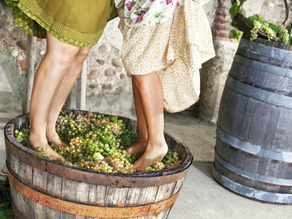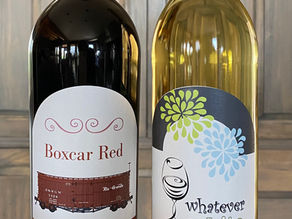Bob's Blog #7: Wine & War -The Climate Change Battle
- Robert Dolci
- Mar 7, 2021
- 5 min read
The following is an email that I sent out to the members of the Norther Rio Grande Chapter of the New Mexico Vine and Wine Society. The comments that I received, for the most part, were very positive. I did seem to “horrify” a few of our members.
Well, what the heck. I have nothing to report but, as in the past, I feel compelled to reach out to you all in an attempt to keep the Northern Rio Grande chapter of the New Mexico Vine and Wine Society at least somewhere in the dark recesses of your mind.
As is my nature, I like to go technical at times. As most of you know, half of our meetings are supposed to cover technical stuff. I do not recall sending out an email that would even remotely be considered technical in nature. Well, it’s about time. Don't let it scare you off.
Let’s have another of my one-sided conversations and discuss war. What does this have to do with wine you ask? War! What is it good for? Absolutely nothing! Huh? What!? Okay, maybe I’m feeling a little bonkers today but If you stick with me you will likely agree that making wine can be like fighting a war.
Of course, I cannot speak to this subject based on personal experience as I do not have a vineyard and I have absolutely no experience cultivating grapes. What I do know is that all major vintners, from all major wine growing regions are concerned with climate change. According to the experts, 85% of the world’s wine growing regions, have been or will be, adversely impacted by human caused climate change.
Okay, I know that some of you are climate change deniers. Or at least you believe that climate change is predominantly caused by natural causes. It is not the intent of my pontifications to try to change your mind. I recognize that that is not my place nor will it bare fruit (grapes).
As some of you know, I worked for NASA, at Ames Research Center, for 30 years. Believe it or not, one of NASA’s primary mission is “mission to planet earth”. What is one of its primary areas of research? Wait for it, wait for it…. Climate change! Yup, climate change. NASA Ames is the primary Center for mission to planet earth. When I was the acting Director for Center Operations, I was expected to sit in on all the various weekly mission briefings. Yes, including those on climate change.
Back to wine:
Several national and international vintner organizations are urging grape growers to diversify grape varieties. As the climate changes, new regions are becoming suitable for grape growing. Unfortunately, established regions are becoming less suitable for the variety of grapes that they are currently growing.
Again, let me say that it is not my intent to convert nonbelievers in human caused climate change. But for those of you that want to have a better understanding of what causes climate change and how it affects grape growing read on. Okay, I dumbed this down. Not for your sake but for mine.
Let’s discuss the natural causes of climate change. Super volcanoes, asteroid impacts and the sun. Well, we haven’t had any major eruptions lately. The last one was over 200 years ago, and it did have a temporary adverse impact on our climate. The last super volcanic eruption was over 27,000 years ago. Yup, major adverse impact on our climate. It caused an ice age. Need I discuss asteroid impact? I think not. On the other hand, if you are a dinosaur denier maybe you don’t believe in climate changing, life altering, asteroid impacts.
So, there is the sun, its surface temperature actually goes through a cycle. Over the last 800,000 years it has gone through several cycles. We are not due for a major sun caused temperature change for a long, very long time. Besides, it’s CO2 that is causing our current climate change. We can’t blame that on the sun.
Do you know what really bugs me? No, of course you don’t so I will tell you. When someone uses freezing temperatures to make their point that global warming is a left wing lie. First off it has nothing to do with politics. It’s all about science. The average global temperature is 56.7 degrees Fahrenheit. Raise your hand if you knew that.
Picture this if you will; you are sitting on a very long teeter totter. Someone of equal weight is sitting on the other end. You’re in a climate-controlled room. Let’s call the room earth. At floor level it is VERY cold, well below zero. Let’s call the floor winter. At the ceiling it is very hot, well over 100. Let’s call the ceiling summer. When the teeter totter is level both of you are at 56.7 degrees. When teetering back and forth when you are hot the other person is cold. When you're real hot, he/she is really cold. The average temperature between the two of you remains a constant 56.7 degrees. Now let’s say that the base of the teeter totter was raised higher in the room such that when the teeter totter is level the temperature is 58.7 degrees. All things being equal you would think that at the ceiling the room would only be two degrees warmer. I’m afraid that it doesn’t work that way. The top can now be 8 degrees warmer, and the floor can be just 6 degrees colder. Don’t get too hung up on the numbers as we are dealing with averages and the temperature changes at the top and the bottom affects the temperatures in between. I’m just trying to illustrate a point. But imagine this, rather than the average hot Phoenix Arizona day being 110 degrees, it was 118 degrees. Guess what? Asphalt melts at 118 degrees. By the way, temps have exceeded 120 degrees in Arizona. What would it be like at 128?
Obviously, droughts have an impact on grape production. Severe rain, hail and windstorms also can destroy crops. During the grape production season, most grape vines do best when daytime temperatures are between 77 and 90 degrees. Two many days outside of that range can affect the available quantity of grapes for harvesting. It can also have a tremendous impact on the wine. The following is a cut and paste:
Elevated sugar content. To make wine, grapes are fermented by the aid of yeasts, which turn sugar into alcohol. Higher temperatures will activate or accelerate the elaboration of sugar in the grape, leading to a higher sugar content and therefore a higher alcohol content. Note from Bob: I have no problem with that!
Reduction in acidity. High temperatures favor a degradation of malic acid in the grapes and the uptake of potassium in the vines, both resulting in less acidic wines. Acidity adds to the flavor of the wine and helps to preserve it.
Modification of the entire taste profile of the wine. Climatic changes also influence the synthesis of aromatic components in the grape (eg polyphenols) which can result in a different flavor of a wine.
Loss of color intensity in red wine. High temperatures also affect anthocyanins, the pigments which give red wine its color, resulting in less colorful red wines.
So, vintners are fighting a war against our changing climate. They are losing and will likely continue to lose the war unless something is done. A 2 degree increase in average temperature will result in the loss of wine grape growing regions by 54%. A 4 degree average increase in temperature will result in the reduction of our current wine grape growing regions by as much as 85%.
Hopefully this didn't bore you to tears.















Comments